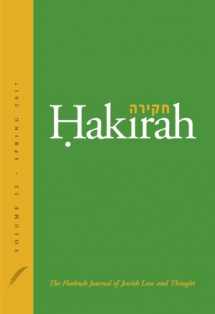
Hakirah: The Flatbush Journal of Jewish Law and Thought
Book details
Summary
Description
In "A Populism of the Spirit" the author traces the roots of this movement to the drive within the human spirit to live according to the principles of the Seven Noachide Laws. The author suggests that this is an opportune time for Torah values to be promoted to a secular world that has lost its way. The presentation of Torah concepts in their most sophisticated form is found in the works of the Rav Yosef Dov Soloveichik zt"l. A review of the Rav's newly published lectures on Moreh Nevukhim, "Maimonides: Between Philosophy and Halakhah" provides an introduction to the body of his philosophical works. Rav Soloveitchik's son-in-law is often considered his successor in the field of Jewish Thought, and an article entitled "I am in the Middle: Rav Aharon Lichtenstein's Vision of Centrist Orthodoxy" explains his positions and how he harmonized the opposing forces that surrounded him. The article in our History section discusses how Orthodoxy has sought to protect itself from being influenced by the secular world. "Austritt--A Tale of Two Cities" claims that Rav Shimshon Raphael Hirsch's pursuit of communal separation is often misunderstood or misjudged by many, and seeks to demonstrate that at times separation is necessary. In an article in the Jewish Law Section, "Women's Aliyyot," the author disputes recent arguments for allowing women to make the blessings for Kriat HaTorah and warns that we will not be able to preserve Judaism by watering it down. In an essay entitled "The Scientific Revolution and Modern Bedikat Tola'im," the author explains the microscope's impact on halakhah and argues for leniency in bedikat tola'im. Another article shows how halakhic practice seems sometimes to have been influenced by disparate factors. In "Did a Piyut Change the Halachah?," the author suggests that the development of a conceptual connection in medieval times between martyrdom and brit milah influenced the practice of a halakhah. And in a translation of an essay by Rav Mordechai Breuer, "Doubts that Aren't," Rav Breuer shows that there are no valid reasons for the reading of the megillah to include repetitions of certain phrases, and demonstrates how errors can lead to the introduction of disruptive minhagim. An article in the Talmud Torah section and another in Jewish Law suggest new insights based on careful readings of Rambam's Mishne Torah coupled with knowledge of concepts he puts forth in Moreh Nevukhim. In "The Religious Phenomenology of Maimonides" the author writes that "much before Habad, an eloquent, if subtle, religious phenomenology was crouching right under our eyes in the work of Maimonides' Mishneh Torah. In "Thieves and Robbers: The Ganav and Gazlan in Jewish Law," the author seeks to demonstrate that these two seemingly similar crimes are categorized in the Torah and in Rambam's Mishneh Torah as the functions of two very different psyches for which completely different responses are needed. In another article in the Talmud Torah section, "Malmad HaTalmidim: A Suppressed Medieval Provencal Ground-breaker," the author introduces us to a classic work of Jewish philosophy and Biblical commentary by Rav Yaakov Antoli, a Torah giant of 13th-century Provence who represents the thought of Rambam and was a major influence on such important scholars as Meiri, and yet whose work is almost unknown today. An edited selection of his work appears in the Hebrew section. The last two essays in the section deal with the building of the first Bait HaMikdosh. In an essay entitled "You Can’t Hurry Love" the author turns to the thought of Rav Tzadok HaKohen to explain a difficult Aggadata dealing with Dovid's building of the foundation of the mikdosh. And in "The Pool of Shlomo HaMelech and the Value of Pi" the author uses methods ranging from the mathematical to the mystical to explain why the mikra uses the approximation of pi as 3.


We would LOVE it if you could help us and other readers by reviewing the book
Book review



